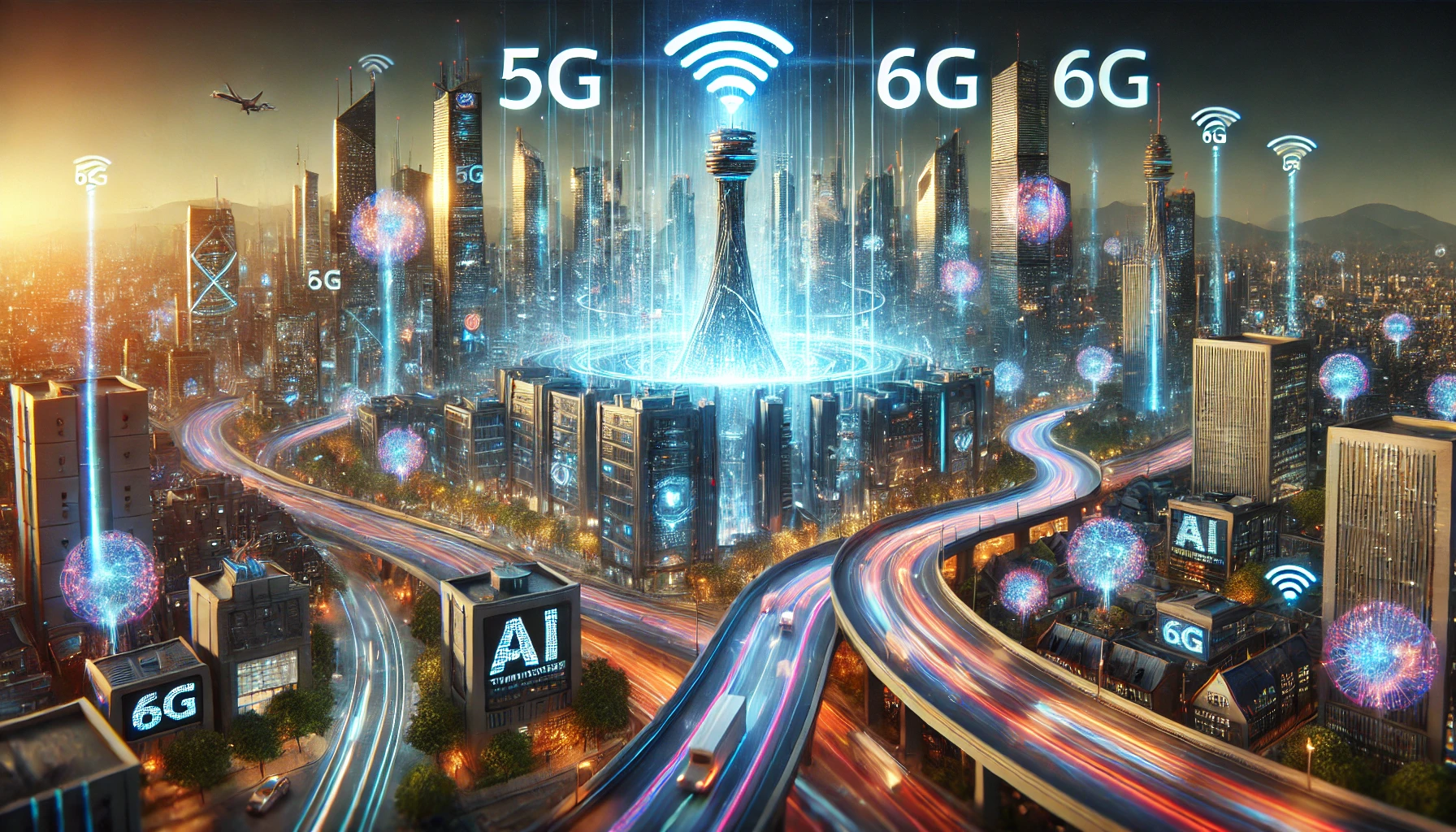
The leap from 5G to 6G isn’t just an upgrade—it’s a paradigm shift poised to reconfigure every facet of our digital lives. In today’s rapidly evolving technological landscape, the promise of 6G goes beyond faster downloads and lower latency; it heralds a future where connectivity becomes almost seamless, transcending traditional boundaries. Let’s dive into the fascinating evolution of wireless technology, examining everything from government initiatives and political buzz to groundbreaking research and insights from celebrities, business moguls, and everyday users alike.
A New Frontier: What Does 6G Bring?
In the world of wireless communication, 6G is envisioned to be the ultimate catalyst for change. While 5G has already redefined our digital experiences with impressive speeds and connectivity, 6G aims to push the envelope further by offering unprecedented data rates, near-zero latency, and a surge in the integration of intelligent technologies.
Imagine a world where you could download an ultra-high-definition film in seconds or engage in real-time holographic calls that feel like face-to-face interactions. This is the promise of 6G—a leap into an era where technology seamlessly melds with daily life. And yet, amidst all the buzz, there are fascinating undercurrents of research, governmental policies, and even nuanced opinions from across the spectrum of society.
Technological Breakthroughs Underpinning 6G
Terahertz Frequency Bands and Advanced Materials
One of the most talked-about aspects of 6G is its use of terahertz (THz) frequencies. Operating within the 0.1 to 10 THz range, these frequencies offer a dramatic increase in bandwidth and data rates. However, such a leap doesn’t come without its challenges—signal attenuation and the need for sophisticated antenna designs demand new materials and inventive engineering solutions. Researchers at various institutions are actively experimenting with nanomaterials and metamaterials to create surfaces that can both absorb and redirect these high-frequency signals efficiently.
Artificial Intelligence and Edge Computing
Incorporating artificial intelligence (AI) into network management isn’t new, but with 6G, AI will be omnipresent. Networks will be self-optimizing, learning user patterns, predicting demand surges, and even pre-emptively troubleshooting issues before they affect connectivity. Coupled with edge computing, where data is processed closer to its source rather than in centralized data centers, the reduction in latency will empower applications like remote surgeries and autonomous vehicles.
Intelligent Surfaces and Smart Infrastructure
The development of intelligent surfaces—materials embedded with sensors and communication technologies—will revolutionize how signals are transmitted and received. Think of walls, windows, or even entire buildings that can actively contribute to a robust network environment. Such innovations are not merely theoretical; labs across the globe are already piloting prototypes that could become the standard in urban connectivity.
Global Race for 6G Leadership
Government Initiatives and Strategic Blueprints
Governments worldwide are not sitting on the sidelines as 6G technologies mature. For instance, the United States is bolstering its infrastructure and cybersecurity measures to maintain a competitive edge, while the European Union has launched ambitious projects like Hexa-X to define the vision and develop the necessary frameworks for 6G networks. In India, strategic implications of 6G are already stirring discussions within the defense sector, as the government explores how next-generation wireless technology can augment national security and strategic capabilities.
- For further reading on government policies, check out NTIA’s blog.
Political Perspectives and Economic Impact
Politically, 6G has become a hot topic. Politicians in various countries are beginning to debate the role of state intervention in the deployment of next-generation networks. In some cases, political leaders emphasize the need for substantial public funding to ensure national security, while others advocate for market-led approaches that encourage private innovation. The global economic stakes are high: with billions of dollars in potential revenue, the race for 6G is set to reshape the digital economy and redefine competitive advantage in the tech sector.
- More details on the global race to 6G can be found on TechSci Research.
Corporate Investments and Market Dynamics
From Silicon Valley boardrooms to board meetings in Beijing and Bangalore, top business executives are weighing in on 6G’s potential. Business moguls believe that the economic impact of 6G could eclipse that of previous wireless generations. With estimates suggesting a multitrillion-dollar market, industries from entertainment to healthcare are bracing for disruption. Major telecom companies are already investing heavily in research and development to secure a leadership position in this new arena.
- For an industry perspective, read Ericsson’s white paper.
Diverse Voices on 6G: Society’s Tapestry
Celebrity, Sports, and Business Insights
Celebrities and sports icons, often known for their influence beyond the realms of entertainment, are also chiming in on the 6G conversation. Several high-profile figures have expressed excitement about the technological revolution, noting how it could revolutionize live sports streaming and virtual fan engagement. Business leaders, meanwhile, are touting the benefits of enhanced connectivity for global trade, citing how instantaneous data transfers and smart connectivity could redefine supply chain efficiencies and boost overall productivity.
Perspectives from the Older Generation
Not all responses to the prospect of 6G are wrapped in excitement. Among older adults, there is a cautious optimism peppered with concerns about privacy and data security. Many worry that the rapid pace of technological change might outstrip the necessary regulatory and social frameworks, potentially leading to unintended consequences. Yet, for others, 6G represents hope—a promise that even those who have seen the evolution of technology over decades can benefit from improved healthcare services, smarter cities, and enhanced communication with family across the globe.
Youthful Enthusiasm and Innovation
Conversely, younger generations are buzzing with anticipation. Millennials and Gen Z, digital natives who have grown up in an era of ever-evolving technology, view 6G as the next logical step in the evolution of connectivity. They are eager for innovations that will fuel advancements in virtual reality, immersive gaming, and even entirely new forms of social interaction that we haven’t yet imagined. For these digital enthusiasts, 6G is not just about speed—it’s about transforming lifestyle and creating new digital economies.
Social Aspects and Everyday Impacts
Beyond the high-octane excitement and corporate boardroom discussions, 6G will have tangible impacts on everyday life. In communities large and small, enhanced connectivity will mean improved access to education, telemedicine, and smart infrastructure that could transform urban planning. However, there is also a social responsibility that comes with such rapid advancements—bridging the digital divide, ensuring equitable access, and safeguarding against potential misuse of technology are challenges that will need a balanced, human-centric approach.
Research Labs and Pioneering Scientific Insights
Cutting-Edge Academic Studies
In academic circles, research into 6G is in full swing. Studies published on platforms like ScienceDirect delve deep into the technical aspects, exploring everything from signal processing challenges to novel algorithms for managing terahertz communications. These investigations not only validate the theoretical potential of 6G but also pave the way for practical implementations.
- A notable study is available on ScienceDirect that explores the intricacies of next-generation wireless systems.
Collaborative International Projects
Scientific research is rarely confined by national borders, and 6G is no exception. Collaborative projects are bringing together researchers from across continents to tackle the technical and ethical challenges of 6G. International research consortia are exploring innovative ideas such as integrating quantum computing with 6G networks and leveraging big data analytics to optimize network performance. Such collaborations are crucial, as they ensure that the technological advancements are inclusive, sustainable, and globally beneficial.
Breakthroughs in Experimentation and Prototyping
Laboratories around the world, from the bustling tech hubs of Silicon Valley to specialized research centers in Europe and Asia, are in a race against time to prototype 6G solutions. These experimental setups are not only testing the boundaries of what’s possible in terms of speed and connectivity but are also experimenting with novel network architectures that could change the way we think about wireless communication entirely.
- For insights on cutting-edge research, explore the findings shared on MindTrades.
Real-World Applications and Use Cases
Transforming Healthcare Delivery
The healthcare industry stands to gain immensely from the advent of 6G. With ultra-low latency, remote surgeries could become commonplace, enabling surgeons to operate on patients thousands of miles away with precision akin to in-person procedures. Moreover, real-time monitoring devices connected through 6G networks could continuously track vital signs and alert medical professionals instantly during emergencies. Such advancements promise not only to enhance patient outcomes but also to redefine the doctor-patient dynamic in the digital age.
Revolutionizing Transportation
Imagine self-driving cars communicating with each other and traffic management systems in real time, reducing accidents and streamlining traffic flow. The reduction in latency that 6G offers is expected to be a game changer in the transportation sector. Autonomous vehicles could become far safer and more efficient, transforming how we navigate cities and inter-city routes. Moreover, smart traffic systems, powered by 6G, could dynamically adjust to real-time road conditions, reducing congestion and environmental impact.
Enriching Entertainment and Media
The entertainment sector, already transformed by streaming and digital media, is set to experience another revolution with 6G. Ultra-high-definition streaming, immersive augmented reality (AR), and virtual reality (VR) experiences will all benefit from the dramatic speed and reliability improvements. Sports events, concerts, and other live events could be broadcast in immersive formats that give viewers the sensation of being right in the middle of the action. Prominent sports figures and celebrities have even speculated on how such innovations might revolutionize fan engagement, turning live events into interactive digital spectacles.
Empowering Smart Cities and IoT
Smart cities of the future will rely on interconnected sensors and devices to manage everything from energy consumption to public safety. With 6G, Internet of Things (IoT) devices can communicate faster and more reliably, creating a highly responsive urban ecosystem. This enhanced connectivity will support everything from efficient waste management systems to real-time pollution tracking, contributing to more sustainable and livable cities.
Enhancing Global Business and Revenue Streams
In the realm of commerce, 6G is expected to open up new revenue streams and transform business operations worldwide. Global markets are already buzzing with predictions that 6G could contribute trillions to the world economy. Multinational corporations, especially in sectors like finance, retail, and logistics, are gearing up to harness the power of ultra-fast networks to drive innovation and operational efficiency. Business analysts suggest that industries adopting 6G will not only experience higher productivity but also generate significant cost savings through automation and improved data analytics.
Important Dates, Timelines, and Geographic Milestones
While the widespread commercial rollout of 6G is still on the horizon, several key dates and milestones are shaping the current landscape:
- 2030: Most experts predict that 6G could become commercially viable around this year, following extensive trials and global standardization.
- 2025: Several pilot projects and government-backed initiatives are underway, marking 2025 as a critical year for laying down the infrastructural and regulatory groundwork.
- Global Hubs: Research and development are particularly robust in regions such as East Asia (especially China, Japan, and South Korea), Europe, and North America. In India, strategic discussions are already underway regarding defense and national security implications of 6G.
These timelines are supported by multiple studies and governmental reports, ensuring that the future of 6G is mapped out with both ambition and caution. For more detailed projections, you might refer to NTIA’s latest report and ScienceDirect’s comprehensive review.
Mixed Emotions: A Social Tapestry of Perspectives
The conversation surrounding 6G is as diverse as the society it aims to serve. Not everyone sees this technological revolution through the same lens, and that diversity of thought adds a rich texture to the debate.
The Cautious Realists
Some segments of society, particularly among older generations, harbor a degree of skepticism. They wonder if rapid innovation might outpace ethical considerations and security measures. Their concerns are valid, as past technological leaps have occasionally led to unforeseen social challenges. These voices remind us that while 6G promises a connected utopia, it must be underpinned by robust privacy safeguards and clear regulatory frameworks.
The Unbridled Optimists
In stark contrast, many younger individuals and tech enthusiasts celebrate the dawn of 6G with unbridled optimism. To them, every new gadget and breakthrough is a step toward a future brimming with possibility—where virtual experiences can rival reality, and creativity finds a whole new canvas in the digital realm. Their social media feeds and tech blogs are awash with discussions about the endless possibilities that 6G might unlock, from revolutionizing online gaming to creating entirely new forms of art and entertainment.
A Convergence of Tradition and Innovation
It’s intriguing to observe how opinions vary even among professionals. Celebrities, renowned for their forward-thinking social engagements, are expressing that the 6G revolution could fundamentally change the way fans interact with their favorite stars, turning passive consumption into immersive experiences. Meanwhile, veteran business leaders emphasize stability and cautious investment, often recalling past technological shifts that required both exuberance and pragmatism. This convergence of tradition and innovation creates an environment ripe for thoughtful discourse and measured progress.
Unpredictable Twists: The Uncertain Journey Ahead
Despite all the optimism and investment, there are inherent uncertainties. Technological development is seldom linear, and the path to fully operational 6G networks is riddled with challenges—from the technical intricacies of THz frequencies to the global coordination required for standardized implementation. Some critics even argue that the rush to 6G could lead to fragmented networks and unforeseen cybersecurity issues. This ambivalence, where promise and peril coexist, makes the journey toward 6G all the more intriguing.
Navigating the Future: Strategic Implications and Call-to-Action
As 6G steadily moves from conceptual frameworks to real-world prototypes, it is clear that this technology is not just about faster connectivity but about reshaping our entire ecosystem—social, economic, and political. Governments, businesses, research labs, and individuals alike must work collaboratively to ensure that this new wave of innovation benefits everyone. Balancing ambition with caution, innovation with ethics, and speed with sustainability will be key.
For those keen on staying ahead of the curve, now is the time to engage with ongoing discussions, subscribe to updates from industry thought leaders, and participate in pilot projects or local tech forums. Whether you’re a tech enthusiast, a policymaker, or simply a curious mind, the 6G revolution promises to touch every part of our lives.
FAQs
Q1: What is 6G technology all about?
A: 6G is envisioned as the next generation of wireless technology, offering dramatically faster speeds, near-zero latency, and enhanced connectivity. It builds upon 5G’s foundation, introducing innovations like terahertz frequency bands, AI-driven network optimization, and edge computing.
Q2: When can we expect 6G to be commercially available?
A: Most experts predict a commercial rollout around 2030, with key pilot projects and foundational research underway by 2025. Timelines may vary based on regulatory, technical, and market factors.
Q3: How will 6G impact industries like healthcare and transportation?
A: In healthcare, 6G will enable remote surgeries, real-time patient monitoring, and more efficient telemedicine services. In transportation, it will enhance autonomous vehicle safety and efficiency through instant communication and smarter traffic management systems.
Q4: Are there any security concerns with the transition to 6G?
A: Yes, while 6G promises unparalleled connectivity, it also brings challenges related to data privacy and cybersecurity. Ensuring robust security measures and ethical standards is a top priority for governments and industry leaders.
Q5: What do experts say about the economic impact of 6G?
A: Business analysts estimate that 6G could add trillions to the global economy, transforming industries and creating new revenue streams. Corporations worldwide are already investing heavily in 6G research and development.
Key Takeaways
- Technological Marvel: 6G will revolutionize wireless communication with terahertz frequencies, AI integration, and intelligent infrastructure.
- Global Race: Governments, from the EU to India, are laying down ambitious blueprints, while political debates emphasize the balance between innovation and security.
- Diverse Perspectives: Opinions on 6G vary widely—from cautious realism among older generations to unbridled optimism among youth and tech enthusiasts.
- Economic Boom: With potential revenue in the multitrillion-dollar range, 6G is expected to transform global business and drive major economic shifts.
- Timelines to Watch: Critical milestones include pilot projects in 2025 and commercial viability around 2030, with research hubs across East Asia, Europe, and North America.
Final Reflections
The transformation from 5G to 6G is more than a technological upgrade—it is a sweeping revolution that will redefine how we interact, work, and live. While the journey is fraught with uncertainties, the collaborative spirit of governments, industries, and communities worldwide is forging a path toward a future of unparalleled connectivity and innovation. As we stand on the brink of this next wireless revolution, it’s clear that the future of communication is not only faster and smarter but also deeply intertwined with the very fabric of our society.
For those looking to explore more about the promising world of 6G, consider visiting authoritative resources like Ericsson’s insights and ScienceDirect’s research articles. Stay informed, stay connected, and be part of the evolution that promises to change the way we see the world.






